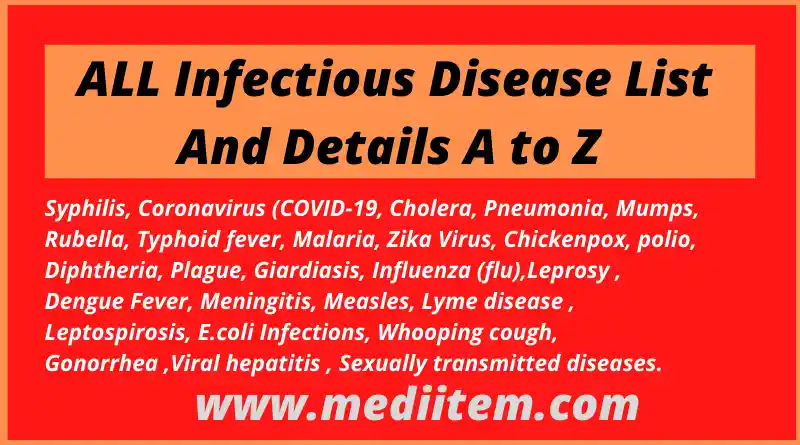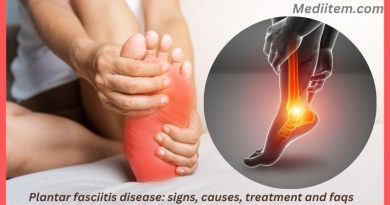Essential infectious disease list and details (a to z)
Essential infectious disease list and details (A to Z) Such as Cholera, Pneumonia, Rubella, Typhoid fever, Malaria, polio, diphtheria, Influenza (flu), Mumps, and TB
What is an infectious disease?
Infectious diseases refer to those diseases that spread from one person to another. This spread is not only human-to-human, but also animal-to-human, animal-to-bird, and human-to-animal.
Currently, due to scientific research in the world, the prevalence of epidemic infectious diseases has decreased to a large extent.
What causes infectious disease?
Answer: The main reason is various types of germs such as viruses, fungi, bacteria, and Many unknown infections, including penicillin, are lurking in front of us but we don’t understand.
When it enters the body, the disease caused is, in a word, an infectious disease.
What are common infectious diseases examples?
Some of the diseases that spread to the human body through the air are mentioned such as diphtheria, measles, swine flu, smallpox, influenza, tuberculosis, and cholera Others, etc.
These diseases occur when the patient sneezes coughs and talks.
Infectious diseases list and summary
Syphilis Summary: At a glance: A sexually transmitted disease caused by the spirochete bacterium Treponema pallidum.
It occurs as a result of sexual intercourse between men and women and may also occur through kissing or receiving blood. So you should avoid such diseases.
There is no strong cure for it, but with current medical advances, most early stages are curable.
Especially through homeopathic allopathic and Biochemic medicine. It can be transmitted from mother to fetus during pregnancy or birth.
Coronavirus (COVID-19): It first spread in epidemic form in China.
Although the disease occurred in 2019, its full name was given in the second week of February 2020.
The World Health Organization gave the official name of the disease as COVID-19, which is an acronym for ‘Coronavirus Disease 2019’. It attacks the lungs. Usually, it takes an average of 5/6 days for symptoms to appear.
The World Health Organization says that the incubation period of the virus lasts up to 14 days. However, according to some researchers, its durability can be up to 24 days.
Its main symptoms are fever, cough, and breathing problems. Symptoms usually begin with a dry cough and fever, followed by difficulty breathing.
- Names of some vaccines are mentioned –
- Oxford = AstraZeneca vaccine
- BioNTech = Pfizer vaccine
- Sinopharm = BBIBP vaccine
- Johnson Moderna vaccine Etc.
In Short Cholera:- is a bacterial infectious disease, It is mainly spread through contaminated food and water. It can enter the body of people of all ages. In short, Vibrio cholerae is an infectious disease of the small intestine.
Its main symptom of cholera is frequent watery diarrhea, nausea, vomiting, dehydration, epilepsy or convulsions, etc.
the disease can be asymptomatic mild, or severe. It was first discovered by a British doctor named John Snow in the Victorian era. Then he thought cholera spread through foul air.
Pneumonia:- bacteria infect the human respiratory system. Pneumonia is spread by fungi, viruses, bacteria, and TB bacteria.
The outbreak of this disease is more common in children during winter.
Infections caused by bacteria such as streptococcus, or respiratory syncytial virus, cause the lungs to swell, reducing the ability to breathe by taking in oxygen. Then there is inflammation in the lungs.
All the symptoms of this disease are common:
The symptoms of pneumonia are different. It depends on the type of infection. Symptoms of pneumonia are as follows: Fever, headache and chest pain, fatigue, cough, sweating, shortness of breath muscle pain, etc.
Treatment: Antibiotics should be taken as per the doctor’s advice.
Rest should be done and meals should be taken at the proper time. Along with that, fruit juice, vegetables, adequate liquid food green tea, etc. are very effective
Rubella:- is a very serious infectious disease caused by a virus. At one time it was very serious. However, due to medical advances, it is not seen much nowadays. But it starts on the face and spreads to different parts of the body.
The rash is small and red in color. If it becomes severe, it can include heart failure, deafness, swelling of the testicles, cataracts, in many cases swollen lymph nodes, hemorrhage, and inflammation of the nerves. Miscarriage can occur early in pregnancy.
Many people confuse it with measles. Konkona is a symptom similar to measles, so it should be treated with caution.
Typhoid fever
Typhoid fever is an infection caused by a type of bacteria called Salmonella typhi. It spreads through contaminated water and food. And there are various symptoms including fever.
Symptoms appear 10 to 14 days after the germ enters the human body.
Diarrhea and vomiting may occur in children. Headache, weakness, body ache, loss of appetite, constipation, gagging, cough, abdominal pain, etc. can occur with fever.
Treatment: Antibiotics or injections can be used as per the doctor’s advice. But in some cases, it can be controlled by medication. Therefore, if all these symptoms appear, it is necessary to treat them at the initial stage.
Essential infectious disease list
Malaria:– is a deadly disease caused by the mosquito-borne Plasmodium parasite. It is only caused by the bite of an infected female Anopheles mosquito.
More than 60 species of malaria have been discovered so far, but 4 species are responsible for human malaria. For example- Falciparum, Plasmodium vivax, malaria, and ovale A. can cause malaria through the bite of a mosquito carrying the virus.
Among these complications, falciparum malaria is the most common.
Main malaria symptoms:
(01) The main symptom of this disease is fever with chills.
(02) Fever can usually range up to 105-106 degrees Fahrenheit.
(03) Fever for 3/4 hours after a certain interval and then one day later.
(04) Severe pain in the body.
(05) Anemia may occur due to the destruction of red blood cells.
Malignant malaria is the most complicated and causes some mental and physical symptoms like convulsions, insomnia, loss of appetite, headache, nausea, constipation, indigestion, profuse sweating, thirst, fatigue, abdominal pain, and enlargement of the spleen and liver. Even kidney failure can cause death.
What can be done to prevent malaria –
To prevent this disease, one must avoid mosquitoes and destroy the source of mosquitoes in the vicinity.
There is something to be done. For example-
Coils or mosquito nets must be used while sleeping at night and during the day.
The accumulated water should be thrown away.
Kerosene sprinkling, creams, sprays, and insecticides should be used.
And take the medicine with the advice of the nearest doctor.
- A Brief Introduction To Zika Virus
- How to Identify and Name Zika Virus:
- Researchers identified this virus in 1947. It is spread by the Aedes mosquito.
- Zika is the name of a forest in the African country of Uganda.
- From there the virus was found inside a monkey.
So researchers have named the virus after this forest Zika virus.
How it spreads:
Zika virus enters the human body with the help of the Aedes mosquito, so it can be said that the Aedes mosquito is responsible for it.
This mosquito also spreads the dengue virus. Zika virus can also spread from an infected person to a healthy person.
Patients affected by this virus do not have any serious problems.
The disease is cured within 5/7 days.
The remedy is to keep yourself safe from mosquitoes.
Chickenpox (Smallpox) Varicella zoster virus
Chickenpox (Smallpox) Varicella zoster virus
Once upon a time hearing the name chicken pox, people used to run away. Because people did not know any medicine or rules for this disease.
Chickenpox starts with fever, mild pain, sore throat, small blisters with water, a stinging sensation inside the body, and indigestion may occur, it looks like a blister.
What should be done for this disease:
It is better to separate clothes, food, and bedding. Also, after 5-6 days of getting pox, bathing in warm water with mild turmeric is very good along with neem leaves.
Making a food list:
Allergic foods should be avoided at this time, such as –
Lentils, brinjal, Pui Shak, shrimp fish, hilsa fish, etc. The food that the patient is allergic to should be completely stopped. Along with that, you should eat nutritious food. Fruits, vegetables, fish. You can eat meat and eggs in quantity.
First Aid: At present, this disease does not require any major medication and cures within 10 to 15 days. But if the pain or itching, even if the fever is high.
So paracetamol, histamine, and various homeopathic medicines are very effective for this type of virus, including Thuja, Rhus Tox, Aconite, Arnica, etc.
There is no need to use ointment or anything else if spots appear on the face or body of this disease. Because it gets cured after 5/6 months. If quick removal of this stain is absolutely necessary – then neem oil can be used along with olive oil.
Poliomyelitis (polio)
It is more commonly known as polio, rather than the poliomyelitis virus.
It reaches from one person to another through people.
Surgeon Jacob Hein (German orthopedic doctor) first discovered poliomyelitis in 1840.
In 1910, this disease hit the world in epidemic form. Countless people died. So began various research to discover, for which they are successful today.
Short notes of diphtheria:-
Currently, Corynebacterium diphtheriae is the most common cause of respiratory system and throat infections in the world.
Diphtheria is a serious disease caused by bacteria causing inflammation of the mucous membrane of the throat and nose, besides fever, sore throat, severe cough, salivation, etc.
In this disease – breathing becomes difficult, the heart stops functioning and the patient may die. Diphtheria is the most affected, especially children up to 6 years. It can happen at any age though.
Risks:
Diphtheria bacteria release deadly toxins after infection. As a result, this toxin spreads through the blood in the body and destroys the functioning of various organs such as the brain, heart, and kidneys. As a result, the risk of death increases.
Remedies: Immunity to diphtheria, pertussis, and whooping cough can be boosted by vaccination (DTaP). This vaccine should be given at the age of 2 months, 4 months, 6 months, 15-19 months, and 4-6 years.
Plague infectious diseases
Deadly Plague: The first plague occurred in 1346, caused by the bacterium Yersinia pestis. Bacteriologist Alexander Irsin was the first to discover it. According to the World Health Organization, 1 out of 5 diseases was called the plague in 2007.
Symptoms: Fever, the patient feels very weak. If the disease is severe, it can lead to typhoid or swelling.
A brief introduction to giardiasis
Giardia lamblia is a microscopic parasite that scientists call an infection of the small intestine.
It is a contagious disease, spread through human contact.
Symptoms include fatigue, nausea, diarrhea, fatty stools, loss of appetite, vomiting, weight loss, headaches, excess gas, abdominal pain, dehydration, etc.
Influenza (flu):-
Flu or influenza is also called a winter disease but it is a viral disease. Can happen at any time, though no major damage is likely. But this disease remains in the human body for a long time. As a result, nasal or respiratory symptoms appear.
Feels somewhat healthy if the weather is warm. Everything, including bathing and ablution, is best done in lukewarm water. Then such diseases can be avoided. Ibuprofen and paracetamol can be taken if the flu causes a high fever and body aches.
Dengue fever:- is an infectious disease in which the virus spreads to humans through the bite of certain Aedes mosquitoes. The full spectrum of symptoms occurs within 3 to 14 days after being bitten by this maggot.
This dengue virus infects the human body more by increasing in summer.
Symptoms of dengue virus: fever, severe muscle aches, headache, joint pain, and skin rash or hives. Also in severe form, Marta’s levels of Anuchakrikika decrease, resulting in bleeding.
If you have this type of fever, first of all, you should rest in a secluded place and eat liquid fruit food.
Especially, you should not take any other medicine except paracetamol medicine. . No pain medication of any kind should be taken as it can increase the risk of bleeding and take a person’s life.
Meningitis:– Meningitis is an inflammation of the meninges caused by viruses, fungi, bacteria, and protozoa. This disease is most common in children and can lead to death, but it can occur at any age.
A Brief Introduction To Measles:- Measles is a contagious viral disease. It is an organism that can spread through the air and can be passed from one human body to another human body through sneezing and coughing.
The symptoms are usually mild and disappear on their own after a few days.
Mumps infectious diseases
It can be anywhere on the sides of the throat, or the upper part. It is red and swollen in the early stages and can cause a lot of pain along with fever and headache and a variety of symptoms including red eyes.
For this, it is best to take paracetamol and various fruit juices. It does not want to decrease easily, so it is possible to resist the virus by strengthening the vitality.
(TB)Tuberculosis disease
Tuberculosis (TB) is a very serious infectious disease, it enters the human body easily, so we need to know about it. You can know all the information about it by clicking on this link. For example –
| 01. ( Summary Of Tuberculosis ) |
| 02. What is tuberculosis? |
| 03. What is the name of the germ of TB disease? |
| 04. Who is most at risk for tuberculosis? |
| 05. What are the increases in tuberculosis? |
| 06. What are the warning signs of tuberculosis? |
| 07. The symptoms of tuberculosis (A to Z) |
| 08. What are the symptoms of tuberculosis tongue? |
| 09. The Diagnosis of TB? |
| 10. The Causes of tuberculosis? |
| 11. What are the Types of tuberculosis? |
| 12. What are pulmonary tuberculosis details? |
| 13. What is Latent TB? |
| 14. What is brain/meningitis Tuberculosis and what details? |
| 15. What is bladder and kidney tuberculosis? |
| 16. The symptoms of abdominal tuberculosis details? |
| 17. How is tuberculosis treatment? |
| 18. What is The TB vaccine Name? |
| 19. The Homeopathic tuberculosis treatment? |
| 20. Prevention of (TB) and more information? |
Lyme disease
Leprosy
Leptospirosis
E. coli Infections
Whooping cough
Gonorrhea
Viral hepatitis
Sexually transmitted diseases
Infectious disease doctors
Doctors who have advanced degrees in various research in infection are appointed to a chamber or hospital. Or we give indications to all the doctors who provide the treatment.
So tell the degreed doctors in your area about this disease and manage yourself properly according to their prescriptions.
Infectious Disease Institute
Institutes in medical colleges that deal with infections or conduct different types of studies, including antibiotic research, are called infection institutes.
In this case, different names are kept in different countries, for example, MBBS Medical College in Bangladesh, so doctors with the highest degree in each country study in the medical school, and separately, those who obtain the highest degree in medicine can be called infection doctors, so contact the highest medical college hospital in the country.
Infectious disease hospital
In the case of this type of disease, usually at the initial stage, various preventive measures should be taken at home. But even after that if the level of infection increases rapidly, then a tertiary hospital should be visited.
It means that every state has a certain big hospital, and that type of hospital should be contacted. Even the head of the department should be contacted for urgent treatment.
What are noninfectious diseases?
More information
YouTube



